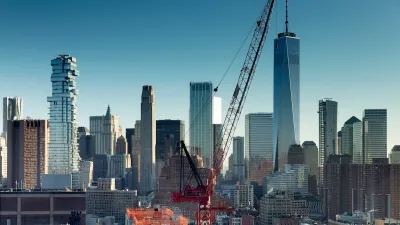This week, I finally got around to looking at the latest (2009) Texas Transportation Institute study on traffic congestion. (1) Two facts struck me as interesting. First, the great congestion surge of the past decade or two is over. In most large metropolitan areas, congestion (measured as hours lost to congestion per traveler) peaked around 2005, and actually declined in 2005-07. For example, in Atlanta, hours lost to congestion peaked at 61, and decreased to 57 by 2007. Congestion increased in only three of the fourteen largest regions (Washington, Detroit and Houston)- and in each of these by only one hour per traveler.
This week, I finally got around to looking at the latest (2009) Texas Transportation Institute study on traffic congestion. (1)
Two facts struck me as interesting. First, the great congestion surge of the past decade or two is over. In most large metropolitan areas, congestion (measured as hours lost to congestion per traveler) peaked around 2005, and actually declined in 2005-07. For example, in Atlanta, hours lost to congestion peaked at 61, and decreased to 57 by 2007. Congestion increased in only three of the fourteen largest regions (Washington, Detroit and Houston)- and in each of these by only one hour per traveler.
Since increased gas prices probably had some effect on driving (and thus on congestion) I suspect that congestion will continue to decline in 2007-09; however, we will have to wait a year or two for data, at least from TTI.
Will reduced congestion have any political impact? Probably not. On the one hand, reduced congestion should make the arguments for new transportation facilities (both roads and transit) less compelling. On the other hand, the severity of the current recession means that transportation lobbies will argue for roads and transit lines as job creators rather than as congestion reducers.
The second thing that grabbed me is the weakness of any correlation between density and long-run congestion increases. Some regions became more dense between 1982 (when TTI statistics began) and others became less dense. Yet both groups experienced comparable congestion increases.
The only "Top 14" region where density (as measured by population per square mile) increased by over 20 percent was Houston, where congestion doubled (from 29 hours per traveler in 1982 to 56 in 2007). This may be because Houston's density is still under 2000 people per square mile, the fourth lowest among large regions and too low to lead to increased public transit use. Both the fastest increase in congestion (Dallas) and the slowest (Phoenix) were in low-density cities where density also increased, though at an even more glacial pace than in Houston.
On the other hand, density nosedived in some older northern cities: by 43 percent in metro Philadephia (from 4083 people per square mile in 1982 to 2329 today) and 35 percent in metro Chicago (from 3726 to 2398). If low density reduced congestion, surely we would see reduced congestion in those places. But in fact, congestion in these regions increased at a pace faster than Houston's: from 15 to 41 hours per traveler in Chicago, and from 16 to 38 in Philadelphia.
(1) The data most relevant to this post are as follows:
Data on congestion trends is online at http://mobility.tamu.edu/ums/congestion_data/tables/national/table_4.pdf .
Data on density trends is online at http://mobility.tamu.edu/ums/congestion_data/ .

Study: Maui’s Plan to Convert Vacation Rentals to Long-Term Housing Could Cause Nearly $1 Billion Economic Loss
The plan would reduce visitor accommodation by 25,% resulting in 1,900 jobs lost.

North Texas Transit Leaders Tout Benefits of TOD for Growing Region
At a summit focused on transit-oriented development, policymakers discussed how North Texas’ expanded light rail system can serve as a tool for economic growth.

Using Old Oil and Gas Wells for Green Energy Storage
Penn State researchers have found that repurposing abandoned oil and gas wells for geothermal-assisted compressed-air energy storage can boost efficiency, reduce environmental risks, and support clean energy and job transitions.

Private Donations Propel Early Restoration of Palisades Playground
Los Angeles has secured over $1.3 million in private funding to restore the Pacific Palisades playground months ahead of schedule, creating a modern, accessible space that supports community healing after recent wildfires.

From Blight to Benefit: Early Results From California’s Equitable Cleanup Program
The Equitable Community Revitalization Grant (ECRG) program is reshaping brownfield redevelopment by prioritizing projects in low-income and environmental justice communities, emphasizing equity, transparency, and community benefits.

Planting Relief: Tackling Las Vegas Heat One Tree at a Time
Nevada Plants, a Las Vegas-based nonprofit, is combating the city’s extreme urban heat by giving away trees to residents in underserved neighborhoods, promoting shade, sustainability, and community health.
Urban Design for Planners 1: Software Tools
This six-course series explores essential urban design concepts using open source software and equips planners with the tools they need to participate fully in the urban design process.
Planning for Universal Design
Learn the tools for implementing Universal Design in planning regulations.
Ascent Environmental
Borough of Carlisle
Institute for Housing and Urban Development Studies (IHS)
City of Grandview
Harvard GSD Executive Education
Toledo-Lucas County Plan Commissions
Salt Lake City
NYU Wagner Graduate School of Public Service




























